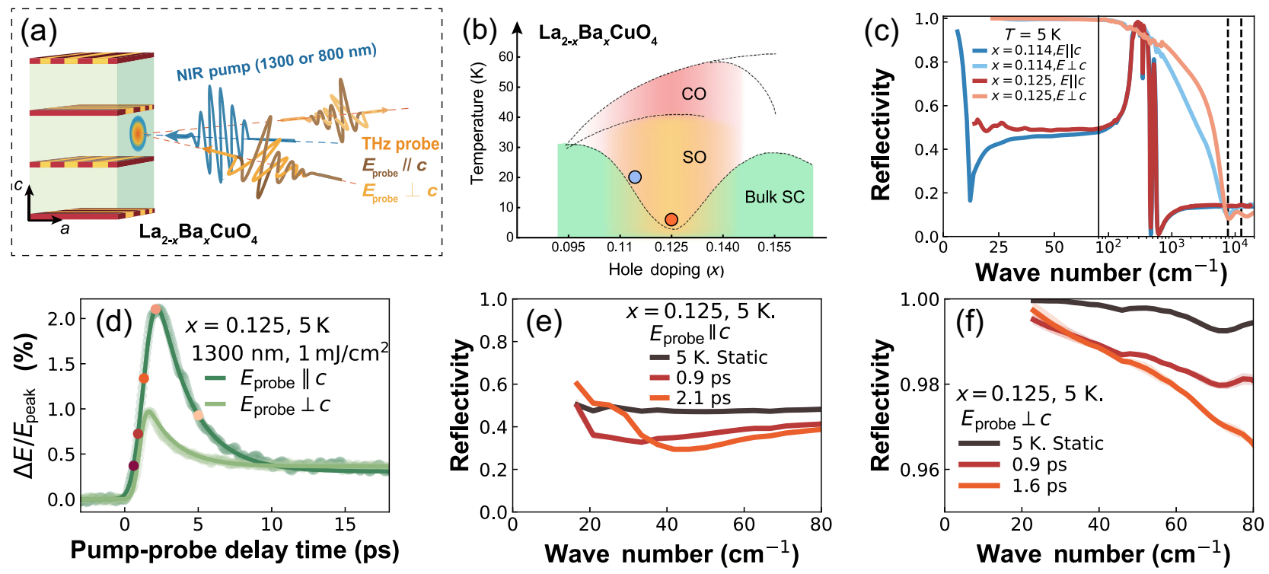Research offers a new glimpse into high-temperature superconductor
Mar 13, 2024
Physical Review X reports Wang Nanlin and collaborators’ work on photoinduced nonequilibrium response of stripe-ordered cuprate La2-xBaxCuO4
Peking University, March 13, 2024: The discovery of transient, light-induced superconductivity in high-temperature superconducting cuprates (HTSCs) has sparked both interest and controversy. One problem is that the observational signature of the transient superconductivity is itself vague: Recent experiments suggest it cannot distinguish between electron Cooper pairs that give rise to superconductivity and quasiparticles with very low scattering rates. Here, Prof. Wang Nanlin’s group at Peking University and collaborators more closely explore the electrodynamics of one HTSC and find the light-induced transient state is not consistent with the equilibrium three-dimensional superconducting state.
The primary indicator of transient superconductivity reported previously has been a sharp upturn in the reflectivity along one of the crystalline axes, the c-axis, being denoted as an analog to the Josephson plasma edge in equilibrium three-dimensional superconducting states. For HTSCs, superconducting condensation within CuO2 planes is essential for facilitating c-axis Josephson coupling. Therefore, measurements of the terahertz response in the CuO2 planes in an HTSC could clarify things: If a transient Josephson plasma edge appears along the c-axis, a response related to superconducting condensation should be seen within the CuO2 planes simultaneously.
To that end, researchers investigate the terahertz responses parallel and perpendicular to the c-axis of La2-xBaxCuO4. They observe an emergent light-induced reflectivity edge along the c-axis, along with a simultaneous decrease of the in-plane reflectivity. Notably, this in-plane behavior is diametrically opposed to the spectral response of superconducting condensation, signifying the vanishing of in-plane superconductivity. Therefore, the observed light-induced c-axis reflectivity edge is fundamentally different from a Josephson plasma edge.
These findings significantly enhance the comprehension of light-induced transient states in HTSCs and contribute new insights into the emerging frontier of ultrafast optical manipulation of quantum materials.
The paper was published online in Physical Review X recently (DOI:https://doi.org/10.1103/PhysRevX.14.011036). The leading author of the paper is Zhang Sijie, a Boya postdoc in Wang Nanlin’s group. Zhang SiJie and Prof. Wang Nanlin at Peking University are the corresponding authors. This work was supported by the National Natural Science Foundation of China, the National Key Research and Development Program of China, and the Office of Science, U.S. Department of Energy.
Link to the paper: https://journals.aps.org/prx/abstract/10.1103/PhysRevX.14.011036

Figure 1. (1) A schematic diagram of the optical pump-terahertz probe measurements on La2-xBaxCuO4. (b) The phase diagram of La2-xBaxCuO4 (reproduced from PhysRevB.83.104506). (c) The broadband in-plane and c-axis reflectance spectra in equilibrium at 5K for x=0.125 and 0.114. The black dashed lines indicate the pump wavelengths used for excitations: 1300 and 800 nm. (d) The decay of the relative change of the reflected terahertz electric field E/Epeak in the x= 0.125 sample after excitations of 1300 nm by a fluence of 1~mJ/cm2 at 5 K. The in-plane and out-of-plane transient responses result from an identical physical process, evidenced by similar decay dynamics. (e) A pump-induced edge appears in the c-axis reflectance spectrum of the x = 0.125 sample. (f) The in-plane transient reflectivity decreases after excitations, similar to the reflectivity at higher temperatures, which significantly differs from the effects of superconducting condensation.
Source: School of Physics
